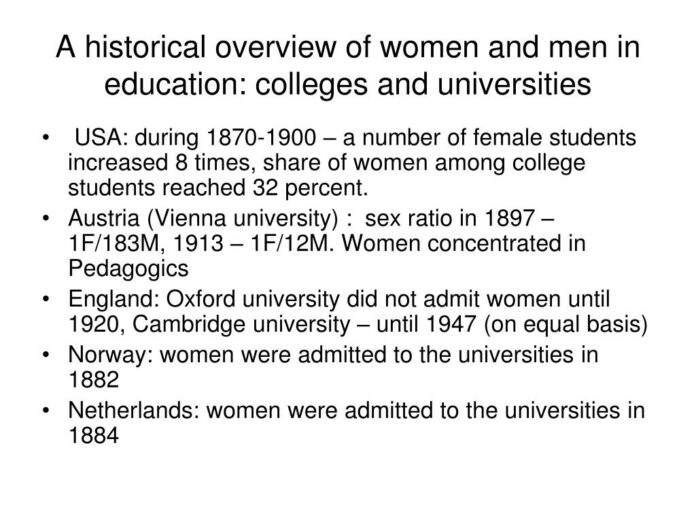The history of education for women is a narrative characterized by profound challenges, resilience, and transformation. In societies across the globe, women’s access to education has often been stymied by patriarchal structures, cultural constraints, and economic barriers. This article explores the layers of women’s educational experiences through various historical epochs, capturing both the strides made and the limitations imposed. It is crucial to contextualize these experiences within broader socio-political movements and the quest for gender equality.
Throughout history, different cultures have defined and navigated the role of women in education in significantly divergent ways. In many ancient civilizations, such as Egypt and Greece, women’s access to formal education was sporadic, often restricted to the elite, with the majority relegated to domestic spheres. This exclusivity provided only a fragment of opportunity, as systemic barriers perpetuated an ideology that prioritized male education as a necessity for societal advancement. The consequences of these attitudes had long-standing implications for women’s roles in both the family and society.
During the Middle Ages, education for women was primarily ecclesiastical, centered around convents and religious orders. While some women gained literacy and were able to read sacred texts, these opportunities were rare and largely contingent upon familial wealth or status. Many women engaged in artisanal trades or supported their households through labor rather than academic pursuits. The prevailing belief that a woman’s education should be limited to serving domestic roles further entrenched a cycle of exclusion and ignorance. As women across Europe faced oppressive conditions, their voices remained largely unheard, yet their potential contributions persisted in the shadows of male-dominated narratives.
The Renaissance era heralded a gradual transformation. Art and literature began to reflect more complex understandings of women and their capabilities. Figures such as Christine de Pizan emerged in literature, advocating for women’s access to education and promoting the idea that intelligence and virtue were not inextricably tied to gender. However, systemic transformation was slow, with most educational institutions still catering predominantly to males. The burgeoning of the university system throughout the late Middle Ages and early Renaissance further solidified this learning dichotomy; it perpetuated a notion of a woman’s place as outside academia and intellectual discourse.
With the advent of the Enlightenment in the 17th and 18th centuries, intellectual thought began to embrace new ideologies that valued reason, knowledge, and the rights of the individual. This era saw the emergence of pioneering advocates for women’s education such as Mary Wollstonecraft, whose seminal work “A Vindication of the Rights of Woman” posited the necessity of education for women to fulfill their roles as rational beings within society. Wollstonecraft’s arguments were radical for her time, challenging the traditional views surrounding female education and urging women’s involvement in broader societal discourses.
The 19th century marked a critical juncture for women’s educational rights, as industrialization prompted a shift in women’s roles within society. More women began to enter the labor force, highlighting the need for educational reform to prepare them for employment. The establishment of institutions dedicated to women’s education gained momentum. Notable figures, such as Emma Willard and Mary Lyon, championed educational advancements and the creation of women’s colleges, seeking to provide women with formal education comparable to that of men.
The influence of the suffrage movement in the late 19th and early 20th centuries had substantial ramifications for women’s education. As women fought for voting rights, they concurrently sought broader access to education as an avenue for empowerment and participation in civic life. The struggle was multidimensional, as it involved not only accessing education but also transforming curricula to include perspectives that celebrated women’s contributions to history, science, and society.
The 20th century ushered in the most profound changes in women’s educational access, coinciding with global movements for civil rights and equality. The post-World War II era witnessed the expansion of educational opportunities for women, particularly in Western societies. Legislation, such as Title IX in the United States, sought to eliminate sex-based discrimination in educational programs, thus granting women equal opportunities in academics and athletics. This legislative framework catalyzed a cultural shift that encouraged women to pursue higher education and professional careers in unprecedented numbers.
Despite these advancements, hurdles remained. In many parts of the world, systemic barriers persisted, from cultural norms that prized women’s domestic roles to economic disparities that limited educational access. Organizations and movements advocating for women’s rights have fought tirelessly to promote educational equity on a global scale. These efforts underscore the recognition that education is a critical pathway to empowerment, economic independence, and societal influence.
Globally, education for women continues to evolve, reflecting the tensions and triumphs of historical struggles. In regions where education is still contested, grassroots movements are emerging, showcasing women’s agency in navigating the complexities of their socio-political landscapes. They emphasize the importance of holistic education that transcends traditional curricula, focusing on critical thinking, leadership skills, and social empowerment.
In conclusion, the historical overview of women’s education delineates a gradual yet resolute progression towards parity. From ancient constraints to contemporary advocacy, the story is characterized by an unwavering quest for knowledge and agency. As society recognizes the pivotal role of education in fostering equality, the collective narrative remains one of hope and determination. Education is not merely a privilege; it is an intrinsic right that empowers women to shape their destinies and contribute to their communities profoundly.
As we reflect on the past and the journeys undertaken, it is imperative to continue advocating for equitable educational opportunities across the globe. The path may be fraught with challenges, but the lessons from history underscore that progress, while often incremental, is possible when vested with resilience and resolve.





























